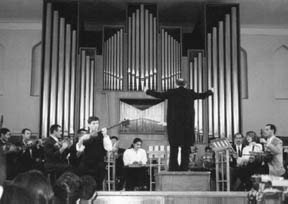|

Winter 1997 (5.4)
Page
65
Pulling Out
All The Stops
Organ Music in
Azerbaijan
by
Tahira Yakubova
  One of the newest types
of musical art which has gained considerable popularity in Azerbaijan
is organ music. One of the newest types
of musical art which has gained considerable popularity in Azerbaijan
is organ music.
Left:
Pipe organ in the Grand
Performance Hall of the Academy of Music.
Its history dates back to the turn of last century when the oil
industry attracted many foreigners here, especially Europeans.
At that time, the Lutheran and Catholic churches in Baku both
had organs and used them for concerts as well as for worship
services.
In 1910, A. Gorsehagen, a graduate of Leipzig High Musical School,
was invited to Baku to perform on the "Walker Organ"
in the "Kirche" (German for "church" referring
to the Lutheran Church in Baku). His evening organ performances
became a tradition and played an important role in the evolution
of Baku's music scene.
When the Soviets
took over in 1920, Stalin decreed that all religious buildings-churches,
temples and mosques-be closed. Many places of worship were destroyed.
In 1939, the pipe organ from the "Kirche" was dismantled
and taken to the Music Conservatory (now, Music Academy). But
in the process of moving, the organ was so badly damaged that
it became impossible to restore.
Organ's Comeback
The
revival of organ culture is largely due to efforts by the first
Azerbaijani organist, Z. Jaffarova, who studied under the famous
Soviet organists I. A. Bryanzo and L. I. Royceman. She became
a professor at the Azerbaijan State Conservatory and under her
guidance about 50 students received training. Since then, many
of them have performed in various cities through the Soviet Union
and on radio and television. Soon afterwards, prominent organ
players came to Baku from many various countries, such as France,
England, German, Sweden, Austria, Italy and Finland.
Pipe organs were built to accommodate this resurgence of interest.
In 1961, a small organ (8 registers) was installed at the Zemann
Firm. In 1964, the concert organ "Oule" (37 registers)
was installed at the Grand Hall of the Conservatory. In 1990,
the new "Rieger Klaus" organ (43 registers) was set
up in the sanctuary of the "kirche" where the acoustics
provide a superb environment for organ, as well as symphonic
and chamber orchestra, concerts.
Composing for Organ
Given
the capabilities of the organ to establish various colorings
and nuances through the use of different registers, the pipe
organ lends itself well to the improvisational mugams of traditional
Azerbaijani music. One of the first works written for the organ
was Kazim Aliverdibeyov's fantasy "Mugam Bayaty-Shiraz."
In the 1960s and 1970s, there was a tendency to create organ
works of the Baroque style in the form of preludes, fugues, chorales,
and fantasies. By the 1980s, artists began writing major pieces
including symphonies which featured the organ as lead instrument.
Among the most well known organ composers is Aref Mirzoyev. Born
in 1944, he was a student of the Azerbaijani composer Gara Garayev.
Mirzoyev's "Organ Symphony in Memory of J.S. Bach"
written in 1984 won the 11th Johann Sebastian Bach Silver Medal
in 1994. Most recently, in November 1996, it was performed in
Westminster Abbey in London by Alexander Fiseisky, the official
organist with the Moscow State Philharmonic Society.
Other notable works include Z. Bagirov's "Passacaglia"
and "Fugue," F. Alizade's "Fantasy" and H.
Mirzazade's "Cycle of 12 Preludes" and "Black
and White."
Tahira Yakubova,
Ph.D. is Professor of Organ at Baku's Academy of Music.
From
Azerbaijan
International
(5.4) Winter 1997
© Azerbaijan International 1997. All Rights Reserved.
Back to Index AI 5.4 (Winter
1997)
AI Home |
Magazine
Choice
| Topics
| Store
| Contact
us
|

